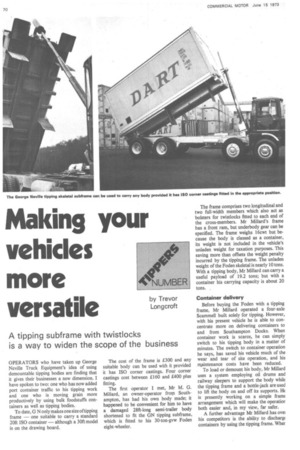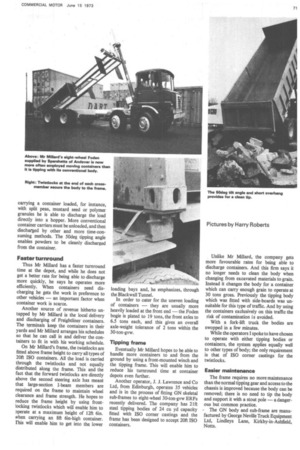Making your vehicles more versatile
Page 72

Page 73

If you've noticed an error in this article please click here to report it so we can fix it.
A tipping subframe with twistlocks is a way to widen the scope of the business
OPERATORS who have taken up George Neville Truck Equipment's idea of using demountable tipping bodies are finding that it gives their businesses a new dimension. I have spoken to two: one who has now added port container traffic to his tipping work and one who is moving grain more productively by using bulk foodstuffs containers as well as tipping bodies.
To date, G N only makes one size of tipping frame — one suitable to carry a standard 20ft ISO container — although a 30ft model is on the drawing board. The cost of the frame is £300 and any suitable body can be used with it provided it has ISO corner castings. Four corner castings cost between £160 and £400 plus fitting.
The first operator I met, Mr M. G. Millard, an owner-operator from Southampton, has had his own body made; it happened to be convenient for him to have a damaged 28ft-long semi-trailer body shortened to fit the GN tipping subframe, which is fitted to his 30-ton-gvw Foden eight-wheeler. The frame comprises two longitudinal and two full-width members which also act as bolsters for twistlocks fitted to each end of the cross-members. Mr Millard's frame has a front ram, but underbody gear can be specified. The frame weighs 16cwt but because the body is classed as a container, its weight is not included in the vehicle's unladen weight for taxation purposes. This saving more than offsets the weight penalty incurred by the tipping frame. The unladen weight of the Foden skeletal is nearly 10 tons. With a tipping body, Mr Millard can carry a useful payload of 19.2 tons; but with a container his carrying capacity is about 20 tons. .
Container delivery Before buying the Foden with a tipping frame, Mr Millard operated a four-axle Scammell built solely for tipping. However, with his present vehicle he is able to concentrate more on delivering containers to and from Southampton Docks. When container work is scarce, he can simply switch to his tipping body in a matter of minutes. The switch to container operation he says, has saved his vehicle much of the wear and tear of site operation, and his maintenance costs have been reduced.
To load or demount his body, Mr Millard uses a system employing oil drums and railway sleepers to support the body while the tipping frame and a bottle-jack are used to lift the body on and off its supports. He is presently working on a simple frame arrangement which will make the operatior both easier and, in my view, far safer.
A further advantage Mr Millard has ova his competitors is the ability to dischargt containers by using the tipping frame. Wher carrying a container loaded, for instance, with split peas, mustard seed or polymer granules he is able to discharge the load directly into a hopper. More conventional container carriers must be unloaded, and then discharged by other and more time-consuming methods. The 50deg tipping angle enables powders to be cleanly discharged from the container.
Faster turnround Thus Mr Millard has a faster turnround time at the depot, and while he does not get a better rate for being able to discharge more quickly, he says he operates more efficiently. When containers need discharging he gets the work in preference to other vehicles — an important factor when container work is scarce.
Another source of revenue hitherto untapped by Mr Millard is the local delivery and discharging of Freightliner containers. The terminals keep the containers in their yards and Mr Millard arranges his schedules so that he can call in and deliver the containers to fit in with his working schedule.
On Mr Millard's frame, the twistlocks are fitted above frame height to carry all types of 20ft ISO containers. All the load is carried through the twistlocks and not equally distributed along the frame. This and the fact that the forward twistlocks are directly above the second steering axle has meant that large-section I-beam members are required on the frame to maintain wheel clearance and frame strength. He hopes to reduce the frame height by using frontlocking twistlocks which will enable him to operate at a maximum height of 12ft 6in. when carrying an 8ft 6in-high container. This will enable him to get into the lower loading bays and, he emphasizes, through the Blackwall Tunnel.
In order to cater for the uneven loading of containers — they are usually more heavily loaded at the front end — the Foden bogie is plated to 19 tons, the front axles to 6.5 tons each, and this gives an overall axle-weight tolerance of 2 tons within the 30-ton-gvw.
Tipping frame Eventually Mr Millard hopes to be able to handle more containers to and from the ground by using a front-mounted winch and the tipping frame. This will enable him to reduce his turnround time at container depots even further.
Another operator, J. J. Lawrence and Co Ltd, from Edinburgh, operates 35 vehicles and is in the process of fitting GN skeletal sub-frames to eight-wheel 30-ton-gvw ERFs recently delivered. The company has 21ft steel tipping bodies of 24 cu yd capacity fitted with ISO corner castings and the frame has been designed to accept 20ft ISO containers. Unlike Mr Millard, the company gets more favourable rates for being able to discharge containers. And this firm says it no longer needs to clean the body when changing from excavated materials to grain. Instead it changes the body for a container which can carry enough grain to operate at 30 tons gross. Previously the tipping body which was fitted with side-boards was unsuitable for this type of traffic. And by using the containers exclusively on this traffic the risk of contamination is avoided.
With a fork-lift truck the bodies are swopped in a few minutes.
While the operators I spoke to have chosen to operate with either tipping bodies or containers, the system applies equally well to other types of body; the only requirement is that of ISO corner castings for the twistlocks.
Easier maintenance The frame requires no more maintenance than the normal tipping gear and access to the chassis is improved because the body can be removed; there is no need to tip the body and support it with a stout pole — a dangerous but common practice.
The GN body and sub-frame are manufactured by George Neville Truck Equipment Ltd, Lindleys Lane, Kirkby-in-Ashfield, Notts.












































































































































